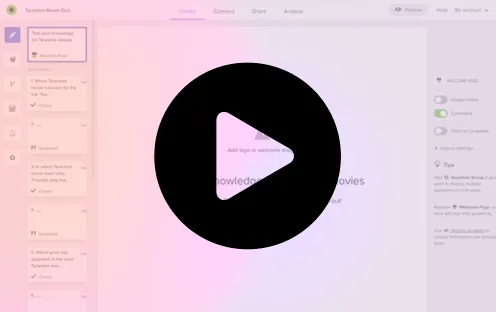
When designing surveys and questionnaires, one of the crucial decisions we face is whether to employ open-ended or closed-ended questions. However, it’s essential to recognize that each type has its own advantages and limitations and serves distinct purposes. In this article, we’ll explore the dynamics between open-ended and closed-ended questions and how their unique characteristics can shape the data we collect.
Open-Ended Questions: Unlocking Depth and Insight
Open-ended questions are free-form survey questions that cannot be answered with a simple “yes” or “no.” Instead, they encourage respondents to provide detailed, thoughtful responses. These questions typically begin with words like “what,” “how,” “why,” and “tell me about.” The responses to these qualitative research questions can be used to attain detailed and descriptive information on a subject.
Qualitative Market Research relies significantly on using open and subjective questions within discussions or conversations. This method involves engaging respondents with queries encouraging detailed and unrestricted responses, allowing for subsequent probing by the researcher based on the respondent’s input.
Advantages of Open-Ended Questions:
- Encourage Exploration: Open-ended questions invite people to delve deeper into their thoughts and feelings. For example, asking, “How do you feel about your job?” allows for a richer response than a close-ended question like, “Do you like your job?”
- Promote Engagement: They stimulate conversation and engagement because they require more than a brief response. People feel heard and valued when they have the opportunity to express themselves.
- Uncover Insights: These questions are valuable in research and interviews as they reveal underlying opinions, motivations, and perspectives. They provide qualitative data that can be invaluable for decision-making.
- Enhance Problem-Solving: Open-ended questions are excellent for brainstorming and problem-solving sessions. They encourage participants to consider various angles and possibilities.
Examples of Open-Ended Questions:
- What are your thoughts on the current state of the economy?
- Can you describe your experience working on that project in detail?
- How do you envision the future of our industry?
- What are your personal goals and aspirations?
- Tell me about your favorite vacation and what made it special.
- What challenges do you anticipate facing in your new role?
- How would you approach solving this complex problem?
- Describe your ideal work environment and why it suits you.
- What are some strategies you use to maintain a healthy work-life balance?
- How do you feel about the recent changes in our company’s policies?
Open-ended Questions in Employee Experience Surveys
Open-ended questions in customer experience surveys are powerful tools for gathering rich and qualitative insights. These questions encourage customers to provide in-depth feedback, offering a more comprehensive understanding of their experiences.
- “Can you describe a recent interaction with our customer support team and how it made you feel?” allows customers to share their personal experiences, shedding light on the emotional aspect of their interaction.
- “What improvements do you believe would make our products or services even better suited to your needs?” invites customers to suggest specific enhancements, providing actionable feedback for business growth.
By incorporating open-ended questions like these into customer experience surveys, companies can tap into the nuanced perspectives of their customers, driving meaningful improvements and fostering stronger customer relationships.
Close-Ended Questions: Seeking Specific Answers
Close-ended questions, on the other hand, have predetermined answer options and can usually be answered with a “yes” or “no” or by selecting from a list of choices. They are concise and straightforward. One of the most popular closed questions in marketing is the Net Promoter Score® (NPS) question, which asks people “How likely are you to recommend this product/service on a scale from 0 to 10?” and uses numerical answers to calculate overall score trends.

Advantages of Close-Ended Questions:
- Efficiency: Close-ended questions are quick and efficient for gathering specific information. For instance, in an online survey, asking, “Did you find the website user-friendly?” provides a clear, quantifiable response.
- Clarity: They are useful when clarifying a point or confirming details without leaving room for ambiguity.
- Comparability: In surveys and data analysis, close-ended questions make comparing responses and drawing statistical conclusions easier.
- Standardization: They ensure consistency in data collection, reducing the risk of interviewer bias.
Examples of Close-Ended Questions:
- Is the temperature comfortable for you?
- Have you ever purchased our product before?
- Did you attend the conference last year?
- Is this your first time visiting our website?
- Did you receive the package we sent last week?
- Are you familiar with our company’s refund policy?
- Is your preferred payment method credit card or cash?
- Did you choose option A or option B for your meal?
- Did you watch the game last night?
- Is the meeting location convenient for you?
- Did you experience any issues with the software installation?
Close-ended Questions in Employee Experience Surveys
Close-ended questions in employee experience surveys are designed to gather specific and quantifiable data, offering a snapshot of employee sentiments.
- “On a scale from 1 to 5, how satisfied are you with your current work-life balance?” provides a clear numeric rating that can be easily analyzed to gauge overall satisfaction levels.
- “Do you feel adequately supported by your immediate supervisor in your day-to-day tasks?” offers a straightforward yes/no response, helping organizations identify areas that may require managerial intervention.
These closed-ended questions provide structured and standardized data, making it easier for businesses to pinpoint improvement areas and track employee satisfaction changes over time, ultimately enhancing the overall employee experience.
When to Use Each Type
- Open-Ended Questions: Use open-ended questions to encourage in-depth discussions, explore feelings and experiences, gather qualitative data, and foster creativity.
- Close-Ended Questions: Utilize close-ended questions when you need specific, quantifiable answers, want to streamline data collection, seek clarity, or ensure consistency in responses.
Choosing between open-ended and close-ended questions in your online surveys is not a one-size-fits-all decision. It depends on your research objectives, the level of detail you require, and the ease of analysis. By strategically incorporating both question types into your survey design, you can strike a balance that maximizes the quality and quantity of insights you gather from your respondents, ultimately leading to more informed decision-making and improved products or services.







